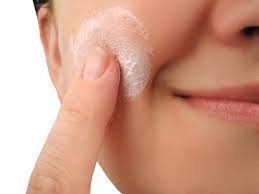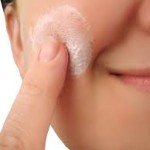Your Skin is a Giant Sponge

 I walked into a classroom when I was substitute teaching years ago and on the bulletin board was a poster with a sponge cut out as a shape of a hand and over the top it read “Your Hands Are Sponges!” The meaning was that our skin sucks up anything that you apply. Think twice before lathering on the sunscreen or moisturizer. Have you read the ingredients and had a good idea what is going in your bloodstream?
I walked into a classroom when I was substitute teaching years ago and on the bulletin board was a poster with a sponge cut out as a shape of a hand and over the top it read “Your Hands Are Sponges!” The meaning was that our skin sucks up anything that you apply. Think twice before lathering on the sunscreen or moisturizer. Have you read the ingredients and had a good idea what is going in your bloodstream?
Remembering that poster I am extremely careful about what I put on my skin. I try to use only ingredients that I would not be afraid to eat. I moisturize with natural items for example, olive oil and coconut oil. I also now live in Florida and do not have to depend on moisturizers as much as I did when I lived in upstate New York and had hot air heat that was so drying.
I also do not use sunscreen (yes, I live in Florida) and stay in the shade instead. I have no tan but if you live in Florida you do not have a tan. We can tell a tourist from a local by their bronze skin. Of course, tourists are sun-starved so I don’t blame for baking on the beach.
What I do for my skin instead is try to keep it healthy from the inside. Drinking plenty of water is very important to keeping your skin hydrated and eating healthy is a must. Here are some other suggestions:
- Limit alcohol
- Skip sugar
- No fast food…ick!
- Fried food-no thank you!
- Skip the gluten
- Eat raw vegetables everyday
- Take your vitamins
- Limit manicures if they involve putting nail polish on your nails
- No on acrylic nails
- Use olive or coconut oil to moisturize lips
- Use a hat if going out in the sun or take an umbrella
- Stay in the shade
- Limit milk products
- Use a mini trampoline (rebounder) to help the lymphatic system
- Use natural products whenever possible
- Don’t expose your skin to harsh weather conditions. (Some of my most athletic friends have baked and wrinkled skin.)
Here are some great resources on natural products.
Here is a typical list of ingredients on sunscreen:
| 8 | Widespread | Detected in nearly every American; found in mother’s milk; 1-to-9% skin penetration in lab studies | Acts like estrogen in the body; alters sperm production in animals; associated with endometriosis in women | Relatively high rates of skin allergy | Janjua 2004, Janjua 2008, Sarveiya 2004, Gonzalez 2006, Rodriguez 2006, Krause 2012 | ||
| 4-MBC | 7 | Pending FDA approval | Found in mothers’ milk; skin penetration in lab studies | Stimulates estrogen-dependent tumor cells; associated with reproductive disorders and behavioral changes in animals | Krause 2012, Janjua 2004, Janjua 2008, Klinubol 2008, Schlumpf 2004 | ||
| 3-BC | 7 | Pending FDA approval | Found in mothers’ milk; skin penetration in lab studies | Hormone-like activity; delays puberty and impairs reproduction in animals | Krause 2012, Durrer 2007, Schlumpf 2004 | ||
| Octinoxate (Octylmethoxycinnamate) | 6 | Widespread | Found in mothers’ milk; less than 1% skin penetration in human and laboratory studies | Hormone-like activity; reproductive system, thyroid and behavioral alterations in animal studies | Moderate rates of skin allergy | Krause 2012, Sarveiya 2004, Rodriguez, 2006, Klinubol 2008 | |
| UV filters with moderate toxicity concerns | |||||||
| Homosalate | 4 | Widespread | Found in mothers’ milk; skin penetration less than 1% in human and laboratory studies | Disrupts estrogen, androgen and progesterone | Toxic breakdown products | Krause 2012, Sarveiya 2004, SCCNFP 2006 | |
| Octisalate | 3 | Widespread; stabilizes avobenzone | Skin penetration in lab studies | Rarely reported skin allergy | Walters 1997, Shaw 2006 Singh 2007 | ||
| Octocrylene | 3 | Widespread | Found in mothers’ milk; skin penetration in lab studies | Relatively high rates of skin allergy | Krause 2012, Bryden 2006, Hayden 2005 | ||
| UV filters with lower toxicity concerns | |||||||
| Titanium Dioxide | 2 (topical use), 6 (powder or spray) | Widespread | No finding of skin penetration | No evidence of hormone disruption | None | Inhalation concerns | Gamer 2006, Nohynek 2007, Wu 2009, Sadrieh 2010, Takeda 2009, Shimizu 2009, Park 2009, IARC 2006b |
| Zinc Oxide | 2 (topical use), 4 (powder or spray) | Widespread; excellent UVA protection | Less than 0.01% skin penetration in human volunteers | No evidence of hormone disruption | None | Inhalation concerns | Gulson 2012, Sayes 2007, Nohynek 2007, SCCS 2012 |
| Avobenzone | 2 | Widespread; best UVA protection of chemical filters | Very limited skin penetration | No evidence of hormone disruption | Relatively high rates of skin allergy | Klinubol 2008, Bryden 2006, Hayden 2005, Montenegro 2008 | |
| Mexoryl SX | 2 | Uncommon; pending FDA approval; offers good, stable UVA protection | Less than 0.16% penetrated the skin of human volunteers | No evidence of hormone disruption | Skin allergy is rare | Benech-Kieffer 2003, Fourtanier2008 | |
| Tinosorb M | 1 | Pending FDA approval; offers good, stable UVA protection | Very limited skin penetration | No evidence of hormone disruption | Skin allergy is rare | Ashby 2001, Mavon 2007, Gonzalez-Perez 2007 | |
| Tinosorb S | 0 | Pending FDA approval; offers good, stable UVA protection | No evidence of hormone disruption | Ashby 2001 | |||
| 6 other ingredients approved in the U.S. are rarely used in sunscreens: benzophenone-4, benzophenone-8, menthyl anthranilate, PABA, Padimate O, and trolamine salicylate | |||||||
The Trouble With Sunscreen Chemicals
Sunscreen chemicals should be engineered with great care. They are used in products intended for repeated application to large portions of the body. To offer effective protection from the sun’s rays, sunscreens must stick to the skin. So-called active ingredients – substances that filter out UVA and UVB radiation – are present in large concentrations.
Over the past decade dozens of studies have examined the potential health hazards of sunscreen chemicals. These include possible skin irritation or allergy, hormone disruption and skin damage that occurs when sunlight acts on sunscreen chemicals.
The federal Food and Drug Administration has not formally reviewed any of the recent studies in this category. Most sunscreen ingredients were already in use in 1978, when the FDA announced its intention to regulate sunscreen safety. Since then the agency has approved just one sun-filtering chemical – avobenzone,
Active ingredients in sunscreens come in two forms, mineral and chemical filters. Each uses a different mechanism for protecting skin and maintaining stability in sunlight. Each may pose hazards to human health.
The most common sunscreens on the market contain chemical filters. These products typically include a combination of three to six of these active ingredients: oxybenzone, avobenzone, octisalate, octocrylene, homosalate and octinoxate.
Nearly every chemical sunscreen contains avobenzone because it is the best agent for filtering skin-damaging UVA rays. However, avobenzone alone may break down when exposed to sunlight. Chemicals such as octocrylene must be added to the product to stabilize it. This practice has become more common in recent years.
Laboratory studies of several sunscreen chemicals indicate that they may mimic hormones and disrupt the hormone system (Krause 2012, Schlumpf 2001, 2004b, 2008). Some research on animals suggests that oxybenzone and two other sunscreen chemicals – 4-MBC and octinoxate – are toxic to reproductive systems or interfere with normal development. (See Table 1)
Experts caution that the unintentional exposure to and toxicity of active ingredients erodes the benefits of sunscreens (Krause 2012, Schlumpf 2010). But most conclude that more sensitive tests are needed to determine whether these ingredients pose risks to sunscreen users (Draelos 2010, Gilbert 2013).
The most problematic of the sunscreen chemicals used in the U.S. is oxybenzone, found in 80 percent of chemical sunscreens. EWG recommends that consumers avoid oxybenzone because it can penetrate the skin, cause allergic skin reactions and may disrupt hormones (Calafat 2008, Rodriguez 2006, Krause 2012). Preliminary investigations of human populations suggest a link between higher concentrations of oxybenzone and its metabolites in the body and increased risk of endometriosis and lower birthweight in daughters (Kunisue 2012, Wolff 2008).
Generally, chemical sunscreens deserve special scrutiny because most are known to permeate the skin to some degree. Two European studies have detected common sunscreen chemicals in mothers’ milk, indicating that the developing fetus and newborns may be exposed to these substances (Schlumpf 2008, Schlumpf 2010). A 2010 study by Margaret Schlumpf of the University of Zurich found at least one sunscreen chemical in 85 percent of milk samples. Four of the chemicals detected are commonly used in U.S. sunscreens.
The federal Centers for Disease Control and Prevention has detected oxybenzone in more than 96 percent of the U.S. population, based on a representative sampling of more than 2,500 Americans children and adults (Calafat 2008). Higher concentrations of oxybenzone were measured in samples collected from participants during the summer months.
The FDA is considering the approval of two sunscreen ingredients used in Europe – 4-methylbenzylidine camphor and 3-benzylidine camphor. Lab studies indicate they may disrupt the hormone system.
Products in EWG’s sunscreen database that utilize minerals to filter UV rays are made with zinc oxide and titanium dioxide, usually in the form of nanoparticles.
Though no ingredient is without hazard or completely effective, on balance our ratings favor these mineral sunscreens. They do not penetrate the skin, and they are stable in the presence of sunlight.
There are some exceptions. Mineral sunscreen could pose a risk of skin damage if manufacturers do not select forms that are coated with inert chemicals to reduce photoactivity. Nano-powders could potentially lodge in the lungs and reach the bloodstream, where they could damage internal organs. To date, no such problems have been reported. Still, FDA should set guidelines and place restrictions on zinc and titanium sunscreens to minimize the risks to sunscreen users and maximize these products’ sun protection.
Safer, more effective solutions may be on the horizon. The European sunscreen chemicals Mexoryl SX, Tinosorb S and Tinosorb M are promising UV filters not yet approved for use in the U.S.
Active ingredient toxicity
This table summarizes human exposure and toxicity information for nine FDA-approved sunscreen chemicals and four ingredients now being considered by the FDA. We asked these questions:
- Will these chemicals penetrate skin and reach living tissues?
- Will they disrupt the hormone system? Can they affect the regulation of the reproductive and thyroid systems and, in the case of fetal or childhood exposure, permanently alter reproductive development or behavior?
- Can some ingredients cause skin allergy?
- What if they are inhaled?
- Other toxicity concerns?
(Source: http://www.ewg.org/2013sunscreen/nanoparticles-in-sunscreen/)

 D5 Creation
D5 Creation
Heather:You would absolutely think so! It was extacly what I thought when I first heard that you could use coconut oil as sunscreen as well. But, I have used it for years now and it works like a charm. I would, of course, suggest testing it out first and see how it goes. We have not had any issues with it (aside from being a bit messy and having to be sure reapply if in and out of water).Coconut oil has a lot of antioxidants that are siad to protect the skin from free radical damage. As with anything . you want to be sensible.